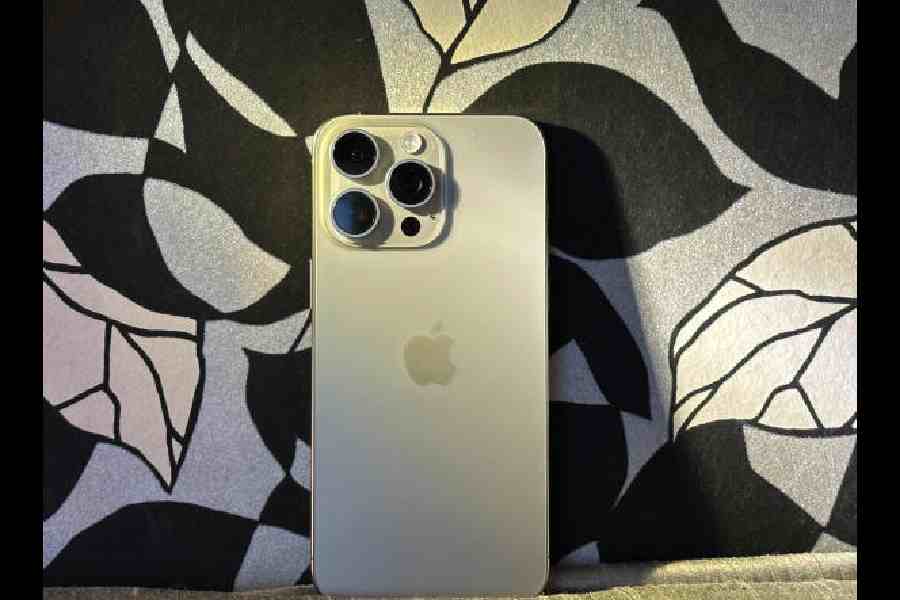Around 16 years ago, the Canon 5D Mark II was released. It started the “DSLR revolution”. Last September, there was another important shift — the arrival of iPhone 15 Pro Max. In 2008, we would laugh while talking about what smartphones could do. Capabilities for true professional cameras now reside in the pockets of millions.

If you want to zoom from the ultra-wide all the way to the five times telephoto, you can do that while recording 4K@60fps
I have spent months — almost six to be exact — with the iPhone 15 Pro Max and each day the phone feels like a new experience. I have not enjoyed a phone this much in a very long time. The thought was reiterated when I recently visited Jaipur just before Holi. Compared to the iPhone 14 Pro Max, the 15 Pro Max is not just better by a small margin; it offers a completely overhauled shooting experience on the iPhone.
The light touch
It’s difficult to explain how much of a difference the titanium design makes. The phone is notably lighter and doesn’t weigh down my pockets nearly as much as I remember it did with the earlier Pro Max models. Yet, it’s not too light, which would have made the device difficult to use. This is beyond the amazing battery life that I have become used to with the Max experience. It’s 2pm and the phone is still rocking more than 75 per cent charge.

The primary camera on the Apple iPhone 15 Pro Max saves 24MP by default, though options for 12MP and 48MP are also available. With 24MP, images with twice the number of pixels get pumped out without the device feeling sluggish
When you are taking photographs or capturing videos over hours, you need a device that’s light and portable. This is the one. Even if you are using a small video rig with the phone, the weight is substantially lower for a device this size.
Paradigm shifts
The iPhone 15 Pro Max changes the way you shoot anything, be it still pictures or videos. Let me give you a small example: Being able to zoom between cameras when recording 4K@60p video. If you want to zoom from the ultra-wide all the way to the five-times telephoto, you can do that while recording. It’s a small detail but it dramatically changes the way you shoot; it’s about convenience and creativity.

Shooting 2x Cinematic makes for a great Goldilocks experience — 1x can be too wide while 3x too tight
You’ll find more of these little operational improvements on the 15 Pro Max, like in Portrait mode you can now pinch to zoom in and out.
In fact, I have been using the dedicated Portrait mode less than before because you may have heard of this headline feature on the iPhone 15 series. Depth data is automatically captured in standard photo mode when there’s a human, cat or dog in the frame. It shoots exactly like a conventional photo but you can later turn “portrait mode” on for that photo in the Photos app. There’s more: As long as you tap to focus on something other than a cat, dog or human, depth data gets captured as long as focus is acquired. This works anywhere within the range of one-time to five times zoom, which means you don’t need to go into Portrait mode; it’s all integrated into the standard photo mode. You instead get into the habit of tapping on your subject for portrait mode. Where Portrait mode could be needed is when capturing a portrait at night.
There is another big paradigm shift on the iPhone 15 series even though we already saw a 48MP main sensor on the iPhone 14 Pros. Earlier, live photos and portrait mode shots were 12MP.

Enable Portrait mode in regular photos. When you’re taking shots, see the f-stop symbol
The primary camera on the Apple iPhone 15 Pro Max saves 24MP by default, though options for 12MP and 48MP are also available. With 24MP, images with twice the number of pixels are getting pumped out without the device feeling sluggish. You can now be a lot more daring when cropping iPhone photos and it’s just nice to enjoy all the extra detail and texture without having to do anything else. It’s a resolution bump without drawbacks.
What surprises me is how there appear to be no compromises in low-light performance despite the increase in resolution. File sizes are going to be huge you say. It may be twice as many pixels but the file sizes aren’t necessarily double. You will get around 30-35 per cent increase in file size.
In case you want to take a full-blown 48MP shot on the main camera, get the settings right in the ProRaw & Resolution control toggle. Remember, file sizes are massive when you shoot in 48MP. A mention needs to be made of the night mode — it’s visibly cleaner compared to the iPhone 14 Pro Max. This is likely due to the improved image processing of the A17 Pro chip.

The iPhone 15 Pro Max can capture the moon to the point it makes sense and not become a blur or an AI-powered image
Before we go further, it’s necessary to mention the different lens options on the phone. The iPhone 15 Pro Max comes with the equivalent of seven pro lenses. You get macro, 13mm ultra-wide f/2.2, 24mm f/1.78 main camera, a 28mm and 35mm FOV shift from that main camera, the 2x 48mm equivalent FOV from the previous iPhone, and finally either 77mm f/2.8 on the iPhone 15 Pro or the new 120mm f/2.8 which comes only on the iPhone 15 Pro Max.
The high-resolution sensor also powers another defining feature on the 15 Pro and 15 Pro Max and that’s the additional focal length options you get on the main camera. If you tap on the 1x icon, it will cycle between 24mm, 28mm and 35mm options. It feels like switching between primary lenses quickly instead of finding a frame on a zoom. You can say with certainty that you shot this or that on a 35mm and not some random in-between focal length on a zoom. Sure, it’s all just different fields of view from a crop of the sensor but this sensor has been designed with extra resolution for this purpose. What you get is an optically correct amount of compression and there’s no loss of detail. There is enough pixel to maintain that 24MP default all the way.
The lens that makes the iPhone 15 Pro Max my favourite is the 120mm equivalent or 5x camera. It packs some serious hardware. The 5x on this iPhone is better than any amount of zoom you get on rival brands. Many brands say you can zoom in on the moon but how comfortable are you with compromising on quality? The iPhone 15 Pro Max can also capture the moon to the point it makes sense.
If you spot something in the distance, train the 5x zoom on the subject. With the 15 Pro Max in your pocket, you begin to look for subjects that are far away. It literally changes the way you look at things. It is impressive how Apple has maintained the f/2.8 aperture on this much longer focal length on a larger sensor without increasing the
size of the camera bump. The tetraprism design is effective but the best part for me is that the tele camera has a similarly bright f/2.8 aperture plus a 25 per cent larger sensor. All that longer reach comes with no compromises to the image quality, including in low light. Further, it’s also well-stablised for a 120mm option; it’s enough to give you jitter-free frames.
Cinema and all that magic
The question we ask ourselves is why we want to replace a cinema camera with a smartphone. There is something about the promptness, the quickness, the ease of use of using a smartphone that appeals to me. Yet, in the past, there have been a few issues while shooting with smartphones. Each time you compare videos taken using a smartphone camera and a professional camera, you may notice a difference when you are viewing them on larger screens. Basically, most smartphones have a lower dynamic range, images are too sharp and, overall, there is a much lower bit rate which reduces the quality of the video. Further, the possibility of playing around with colours or combining videos shot on a smartphone with those shot using other cameras is low.

If you want to take a full-blown 48MP shot on the main camera, get the settings right in the ProRaw & Resolution control toggle
Two years ago, things started changing with the arrival of the iPhone 13 Pro. Apple introduced the possibility to shoot in a larger video format — ProRes. The format results in files that are larger than HEVC.
This year, Apple changed the game with ProRes Log. The final file sizes are massive but you get a much higher bit rate. Helping the cause is the change in the file delivery system — USB-C. You can easily attach an external memory storage device and gigs after gigs can get stored there. You need it, you really do because shooting even a minute of ProRes Log means using up a lot of space. Now you can retain a lot more information about a video file to make changes later.
Hang on, I am getting ahead of myself. ProRes Log is the reason why footage shot on a smartphone won’t look like it has been shot on a smartphone. Apple Log is not a filter; it is a professional tool for filmmakers. As soon as you begin shooting in ProRes Log mode, the image starts getting treated in a completely different way. There is no local tone mapping when you shoot in Log.
Local tone mapping refers to selectively brightening or darkening certain portions of an image. In conventional video mode, your iPhone will do this even if you’ve locked your exposure. In ProRes Log this does not happen. It’s this lack of processing that gives you a particularly noticeable advantage when using controlled lighting.
Tone mapping isn’t a bad thing most of the time. It works wonders without us even noticing. For day-to-day shooting, it’s the only way to cram a contrasty scene into a frame of normal-looking video. When you shoot ProRes Log, in post-production, you can apply LUTs to give it the cinematic feel. You can play around with light and darkness… with colours and more.
Cinema with Cinematic Mode
For the last few years, Apple has been offering something called the Cinematic Mode, which is the rack-focus effect that you get on expensive video cameras. While shooting a video, you can lock the focus on a person but when the character looks away, the focus shifts to the other face in the frame, only to shift back to the primary person when he or she looks at the camera again. The best part of the deal: If you think the focus is not spot on, that can be changed in post-production.

With the 15 Pro Max in your pocket, you begin to look for subjects that are far away, so that you can use the 5X zoom. It changes the way you look at things
What’s different now is that you can zoom in and out when recording. You can zoom continuously between the two native options of 1x and 2x.
After all these months, what I have experienced is the pinnacle of smartphone photography making confident strides into the hearts of photo enthusiasts. No wonder this is the most powerful iPhone to date, with a stunning camera that makes everyday photos extra special.










